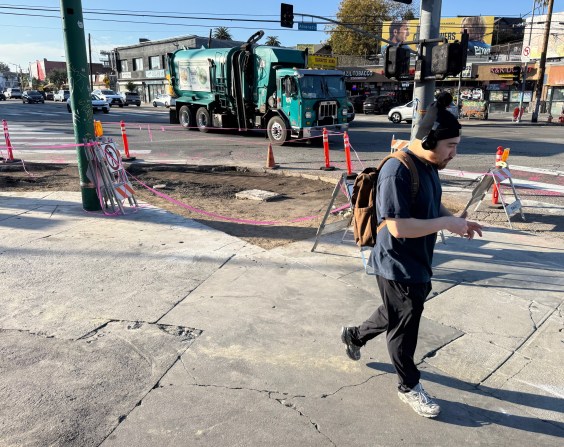This was originally posted at the Natural Resources Defense Council's staff blog.
In a state struggling with infrastructure costs, furiously figuring out how we can pay for road maintenance, and working towards achieving ambitious climate goals that require a reduction in car travel...we're still building more roads. Slowly but surely, that is starting to change. The state is shifting direction to transportation that will better serve people, the economy, and the environment.
Did you know that transportation makes up 40% of California's greenhouse gas emissions? That's 40% of emissions from ALL sources. The state has been working to reduce this number, but as you might imagine, this sort of transformation is no small feat.
To help tell the story, we've recorded a three part series of discussions between experts on California's transportation issues. Let your transportation geek flag fly, and check out part one, How California is Remaking its Transportation System for People and their Environment.
Here's a taste of what you might hear in the audio series about the state's progress so far:
- The California Environmental Quality Act measurement of transportation impacts has been fundamentally reformed to better focus on the goal of reducing greenhouse gas emissions.
- Every major region in the state has adopted a Sustainable Communities Strategy under the groundbreaking Sustainable Communities and Climate Protection Act (SB 375) that integrates transportation, land use, and housing to reduce greenhouse gas emissions.
- Sixty percent of cap and trade revenues will be allocated to projects that reduce emissions from the transportation sector.
- The California State Transportation Agency--the relatively new agency that governs all transportation functions of the state--is focused on improving transit, biking, and walking.
- The California Department of Transportation, or Caltrans, has a new mission statement that includes sustainability. And, Caltrans just released their new, amazingly forward-looking Strategic Plan...we'll wait to say more about this in a future blog.
We've made strides, but there is still work to be done.
Fortunately, there is a great opportunity right now to help California transform its transportation system. Caltrans is currently working hard on drafting a new California Transportation Plan, responding to a 2009 law that notes "the state lacks a comprehensive, statewide, multimodal planning process...consistent with the state's greenhouse gas emission limits."
The draft Plan analyzes three possible future scenarios, and concludes that only one achieves the state's climate goals. No surprises here--it's the scenario that includes ALL available strategies. We need to reduce car travel, we need to make our vehicles more efficient, and we need to clean our fuels - all by a lot.
We commend Caltrans for the overall direction of the Plan. It is aligned with the state policy goals relating to climate mitigation and adaptation, reducing vehicle miles traveled, increasing accessibility, protecting natural and agricultural resources, and addressing social equity. In addition, Caltrans makes some admirable recommendations in the plan, including "avoid funding projects that add road capacity and increased maintenance costs". While it wouldn't be a surprise to hear me say that, for a department whose predecessor is the Bureau of Highways, we applaud Caltrans evolving to better meet 21st century priorities.
But, the plan still needs improvement. It includes advanced modeling and analysis that proves we must act boldly, but, the draft does not provide clear next steps. Without clear, actionable recommendations, it could be easily ignored.
Caltrans is accepting public comment until April 17th, this Friday. Join NRDC and tell Caltrans:
"We applaud Caltrans for prioritizing state policy goals, including reducing vehicle miles traveled, increasing accessibility, and promoting social equity in the draft California Transportation Plan 2040. However, in order for the California Transportation Plan 2040 to be effective in its legislative mandate to identify the statewide transportation system needed to achieve the state's climate goals, the alternative scenarios modeled in the plan need to inform actionable recommendations. It is good to know that doubling transit service helps achieve the state goals. It is more helpful to know some policy changes and investment decisions that will achieve this. Caltrans should model "Policies" instead of "Objectives." Based on the results of the modeling analysis, Caltrans should make specific recommendations that will achieve a robust transportation system that meets the state's climate goals."
If you want to learn more about the Plan, check out this blog by our ally ClimatePlan. And definitely stay tuned for parts 2 & 3 of our series!





